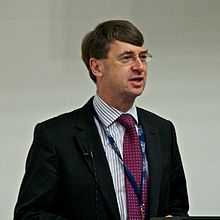Roger Davies (astrophysicist)
| Roger Llewlyn Davies | |
|---|---|
 Roger Davies presenting at the National Astronomy Meeting 2012 | |
| Born | 13 January 1954 |
| Nationality | British |
| Occupation | Astronomer |
Roger Llewelyn Davies (born 13 January 1954) is a British astronomer and cosmologist, one of the so-called Seven Samurai collaboration who discovered an apparent concentration of mass in the Universe called the Great Attractor.[1] He is the Philip Wetton Professor of Astrophysics at Oxford University.[2] In May 2010 he became President of the Royal Astronomical Society, a post he held for two years, until May 2012.
Early life and education
Davies was born in Scunthorpe, Lincolnshire, and grew up there, attending John Leggott Grammar School. A school project fired his interest in astronomy, augmented by his parents’ purchase of a small telescope. As a teenager Davies also attended evening classes run by the Workers' Educational Association, becoming a lifelong supporter of astronomy outreach work.
Career and research
Davies took his first degree at University College London and his PhD at the Institute of Astronomy and Churchill College, Cambridge. Posts at Lick Observatory, then Cambridge and Kitt Peak National Observatory followed. While at Kitt Peak he became part of the Seven Samurai collaboration which surveyed the distances and velocities of 400 nearby elliptical galaxies, discovering the Great Attractor, at that time thought to be pulling the Milky Way and other galaxies in the direction of the constellations of Hydra and Centaurus. Returning to the UK, Davies was based in Oxford leading the team that developed a proposal for UK participation in an 8-m telescope project which ultimately led to the establishment of the Gemini Observatory. He became Head of Astronomy at Durham University in 1994 where he developed his interest in integral field spectroscopy and played a leading role in building instruments for Gemini (GMOS)[3] and the William Herschel Telescope (SAURON).[4][5] He used these to map the motions and composition of the gas and stars in galaxies leading to new insights into galaxy evolution.
Davies returned to Oxford in 2002 as Philip Wetton Professor of Astrophysics (a post he holds in conjunction with a fellowship at Christ Church, Oxford) where he pursues research in cosmology and the evolution of galaxies. He is now engaged in planning instruments for the European Extremely Large Telescope, a 39-m diameter telescope to be constructed in Chile.
As President of the Royal Astronomical Society between 2010 and 2012, Davies worked with the RAS community to make the continued case for astronomy and geophysics, an area in which the UK excels, against the backdrop of deep cuts in spending by the UK government.
External links
References
- ↑ Lynden-Bell, D. et al., Spectroscopy and photometry of elliptical galaxies. V – Galaxy streaming toward the new supergalactic center, Astrophysical Journal vol. 326, March 1, 1988, p. 19–49.
- ↑ Oxford Astrophysics Members – Professor Roger Davies
- ↑ The GMOS Integral Field Unit
- ↑ SAURON: Integral-field Spectroscopy of Galaxies
- ↑ SAURON: First Results from Wide-field 3D-Spectroscopy of Galaxies